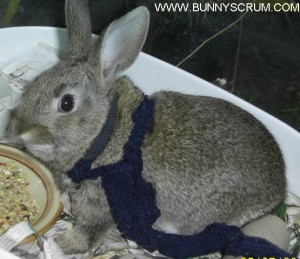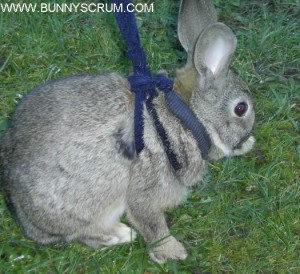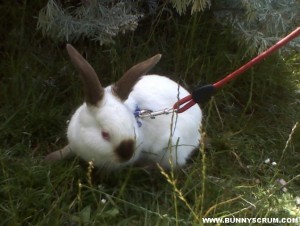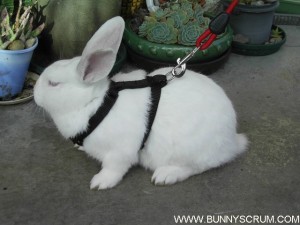There is nothing like taking your rabbit for a bit of a run or to go visiting friends.
Being able to control your animal and, above all, keeping him safe is essential. Rabbits can be taught, from a very young age, to be on a lead with a cat or small dog harness that goes around the chest and stomach. To introduce your bunny to the ‘feel’ of a restraint, a sock harness can be made up in the same configuration as the commercially made product.
Initially, place this ‘sock harness’ on him while he is having his breakfast as he will be more focused on food than feeling restrained. Gradually move him from one food bowl to another by gently pulling on the centre strap on his back. Take away the first bowl.
- Add the lead to the harness as he gets used to the added weight of the metal clasp of the lead.
- Place his dinner at one end of a hallway and bunny at the other end. If you do not have a person to help you, just cover his eyes over with a loose cloth, so that he doesn’t see his food bowl, until you are 2-3 metres away. Keep him on a short lead roughly half at this stage so that he can only hop slowly making sure that you are in control of his speed at all times. Don’t let your rabbit try to reverse on you and subsequently try to pull off the harness, so keep behind him at all times.
- When bunny has perfected this skill, you can put him on the full extension of the lead and allow him to go as fast as he likes. He is now ready for the outside world.
4. If your rabbit is a hutch dweller, he will especially appreciate the exercise and new experiences, for example: going to the beach, visiting friends and their pets.
If he looks tired, while taking him for a walk, just put him into a calico bag and resume your own walk. Experiencing different sounds, people and animals you meet will make your bunny more socially adjusted and less scared of the world.
N.B. Be cautious which animals you introduce bunny to. You don’t want him to have a bad experience, injured or even get eaten. (Know your cat! – Notorious for changing moods – a nice pussy can turn into a vampire bat! )
Rabbits have soft pads on their feet, so don’t over do running him on a concrete surface, even though it will help to wear down his toenails.
CONSTRUCTION OF A SOCK HARNESS AND LEAD
Take several recycled old socks. Cut into 4-5 cm width loops out of the ankle portion down to the heel. To make a chain, make 2 circles – Left hand side ‘A’ and Right hand side ‘B’
1. Place ‘B’ on top of ’A’ to make the number eight on its side with the zero in the middle.
2. On the right hand side of ’A’ and the figure zero, pull the loop over the left hand side of ‘B’ and under the left hand side of ’A’ and then pull the ends.
3. Add additional loops to get the length you desire.
FITTING OF A HOMEMADE SOCK HARNESS
Open up the first loop and put it over your rabbit’s head, being sure that the knot is on the top of the back of his neck. The second loop goes through the right front paw with the knot locating in the centre of his chest. Open up the third loop and place his left paw through, take it up to the centre of his back and tie it onto the second loop. Your young rabbit is now secure and you can add a lead or extend the soft lead.
(See also: photos and instructional video on ‘faux’ rabbit, come toy possum -see photos below)











